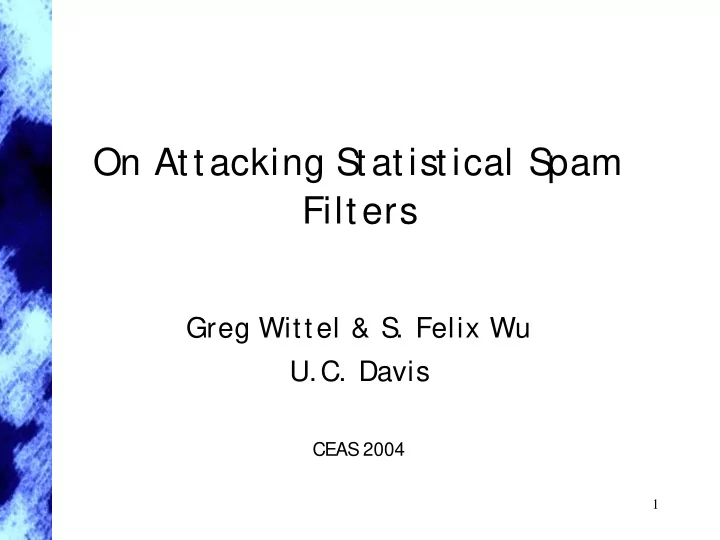

On Attacking S tatistical S pam Filters Greg Wittel & S . Felix Wu U.C. Davis CEAS 2004 1
Outline • Introduction • Attack Classes • Testing A New Attack • Conclusions & Future 2
Attack Classes • Attempted attack methods: – Tokenization • Works against feature selection by splitting or modifying key message features • e.g. S plitting up words with spaces, HTML tricks – Obfuscation • Use encoding or misdirection to hide contents from filter • e.g. HTML/ URL encoding, letter substitution 3
Attack Classes cont. – Weak Statistical • S kew message statistics by adding in random data • e.g. Add in random words, fake HTML tags, random text excerpts – Strong Statistical • Differentiated from ‘ weak’ attacks by using more intelligence in the attack • Guessing v. educated guessing • e.g. Graham-Cumming Attack 4
Attack Classes cont. – Misc: • S parse Data attack • Hash breaking attacks 5
Testing A New Attack • Tested two types of attacks: – Dictionary word attack (old) – Common word attack (new) • Both attacks add n random words to a base message. • Tested against two filters: – CRM114 - S parse binary poly. + Naïve Bayesian – SpamBayes (S B) - Naïve bayesian 6
Procedure • Training data – 3000 hams from S pamAssassin corpus – 3000 spams from S pamArchive-mod corpus – CRM114 trained on errors – SB using bulk training 7
Procedure cont. • Test data – Started with a base ‘ picospam’ not in training data: From: Kelsey Stone <bouhooh@entitlement.com> To: submit@spamarchive.org Subject: Erase hidden Spies or Trojan Horses from your computer Erase E-Spyware from your computer http://boozofoof.spywiper.biz 8
Procedure cont. • Test data cont. – Base picospam is detectable by filters – Generated 1000 variations with n words added. • Words selected with and without replacement • n = 10, 25, 50, 100, 200, 300, 400 – Recorded classifications, effect on score 9
Results • Using 10,000 variants didn’ t effect results • S election with/ without replacement had no effect • Mixed results 10
CRM114 Results • Both attacks failed; 0 false negatives • S pam score was effected... 11
CRM114 Results cont. 1 0.95 Base score Spam probability 0.9 0.85 0.8 Dictionary Common 0.75 0 10 25 50 100 200 300 400 Words added 12
SpamBayes Results • Baseline Dictionary attack: mild success • Common word attack... 13
S pamBayes Results cont. Dictionary 1 Common Spam Thresh. 0.8 Spam probability 0.6 0.4 0.2 Ham Thresh. 0 0 10 25 50 100 200 300 400 Words added 14
S pamBayes Results cont. • Common word attack reduces attack size by up to 4x • What Happened? Why such poor performance on either attack? • Hypothesis: Basis picospam was not in training data. • Added the basis spam to S B’ s training data… 15
S pamBayes Results Part 2 • Retrained filter offered greater resistance to ‘ weak’ dictionary attack. • S mall performance gain against common word attack. • Gains not big enough to resist attack 16
S pamBayes Results Part 2 cont. Dict ionary Word Attack Before 1 After Spam Thresh. 0.8 Spam probability 0.6 0.4 0.2 Ham Thresh. 0 0 10 25 50 100 200 300 400 Words added 17
S pamBayes Results Part 2 cont. Common Word At tack Before 1 After Spam Thresh. 0.8 Spam probability 0.6 0.4 0.2 Ham Thresh. 0 0 10 25 50 100 200 300 400 Words added 18
Conclusion & Future... • Mixed success of common word attack shows need for further study • Other filters – Bogofilter shows similar vulnerability • Effect of re-training on attack msgs v. – False negative, false positive rate • Testing other basis picospams 19
Future cont. • What makes a filter hard to distract? • Relevance of independence assumption • More advanced attacks – Natural language generation • Traditional software flaws – Exploitable buffer overflows – Remote code execution 20
Colophon • Contact information: – Greg Wittel ( wittel at cs . ucdavis . edu ) – S. Felix Wu ( wu at cs . ucdavis . edu ) • Questions? 21
Recommend
More recommend